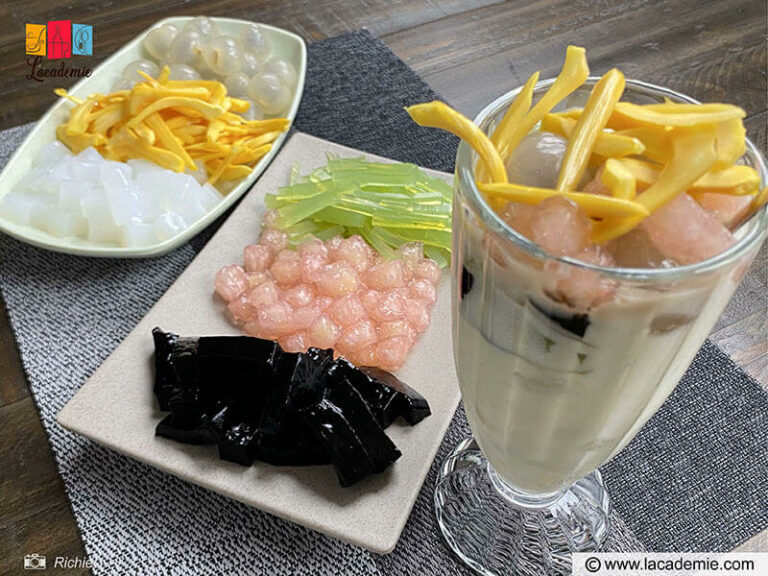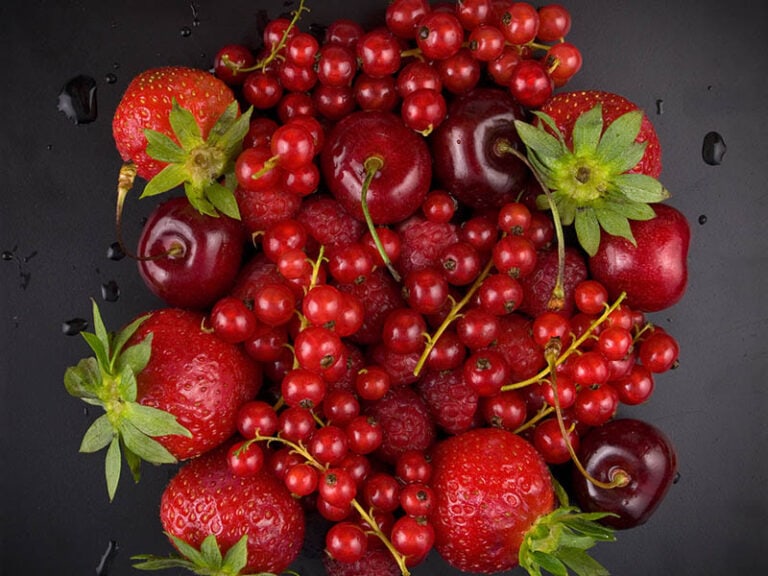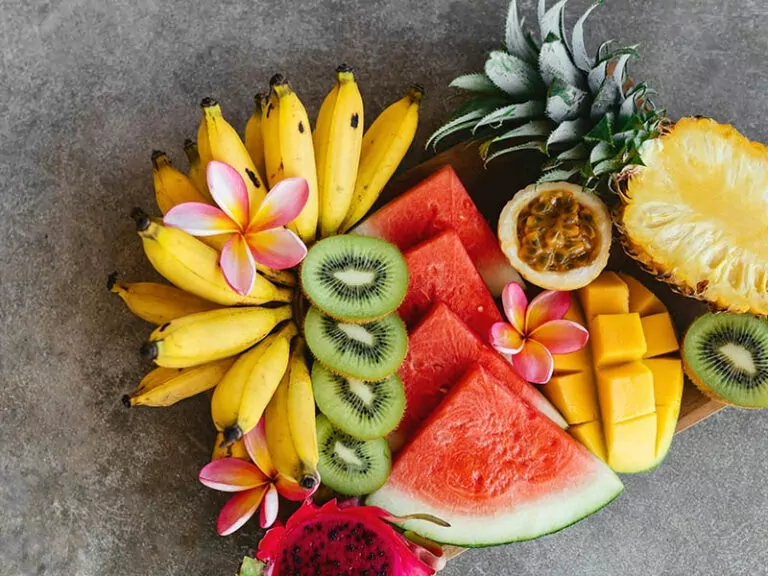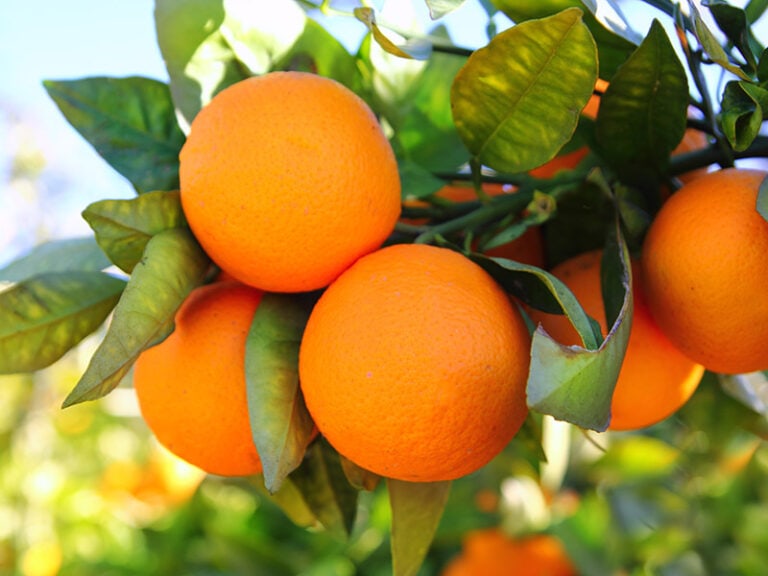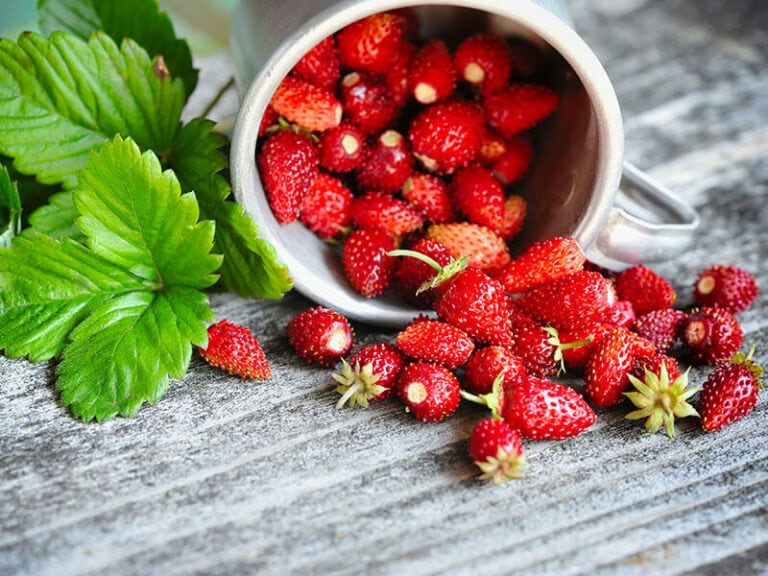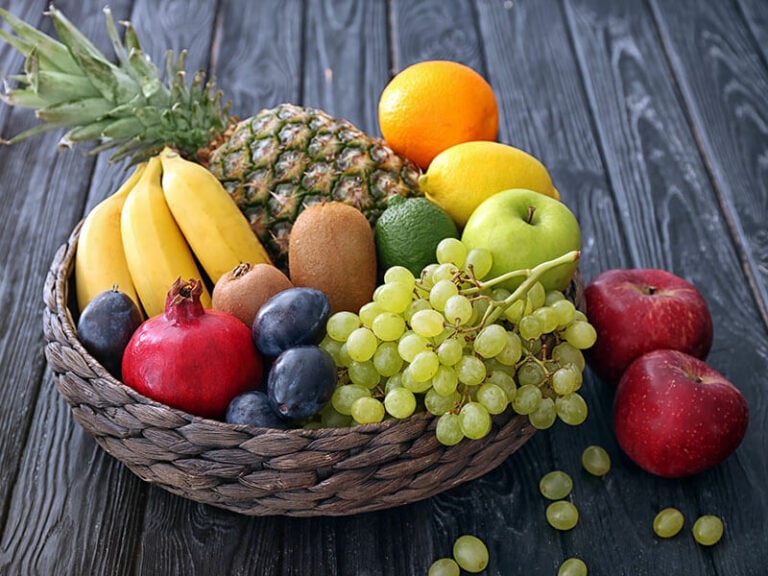Learning how to thaw frozen fruit is important for those who love eating fruits. It is clear to see that frozen fruit is affordable, delicious, and convenient. But if you find it hard to thaw them properly, this article will provide you with the best answer.
In a busy life, many people do not have time to buy and prepare food. Therefore, frozen foods, including fruits, become the best choice. The only problem here is the thawing process might take time.
However, improper thawing can cause food to deteriorate and even produce toxins that are harmful to health. Here is the best, safest, and fastest way to thaw frozen fruit that you should try as soon as possible.
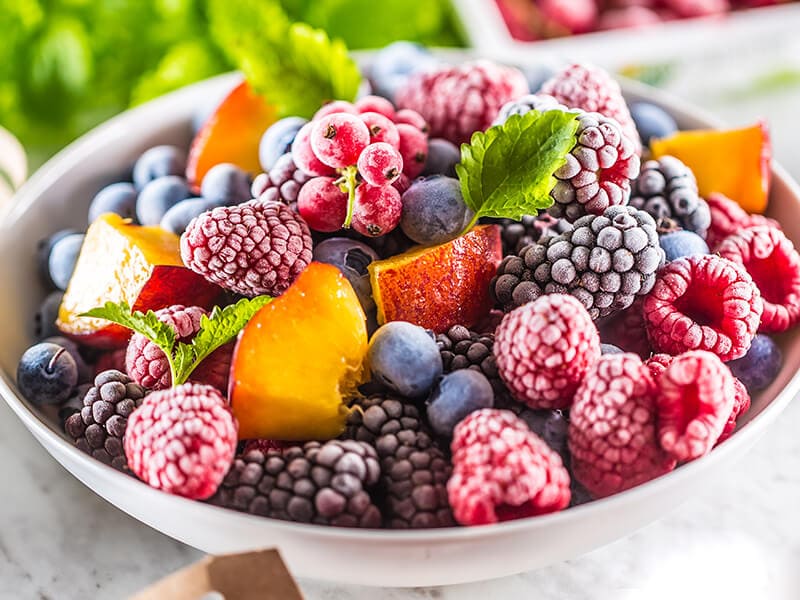
Why Should You Thaw Frozen Fruit Correctly?
Frozen food, if thawed improperly, will go rancid and form bacteria. It is the cause of poisoning and diarrhea, especially for people with sensitive digestive systems. Therefore, you must keep frozen food, like fruits, in a safe temperature zone and thaw them properly.
Fruit is perfectly safe when frozen. However, when you start to defrost them and their temperature reaches more than 40 °F, the bacteria can multiply.
If thawed at room temperature, the surface of the fruit becomes an ideal environment for pre-existing bacteria to grow and thrive. According to research, the Danger Zone is generally between 40 and 140°F – the temperature range for multiplying bacterias (1).
And you should not thaw frozen fruit with hot water for this reason. The hot water temperature is not enough to speed up the defrosting process. However, by this time, the fruit surface has been partially cooked, and large numbers of bacteria are multiplying.
There are 3 good ways to safely thaw your frozen fruit (2). Keep scrolling down to the next section and find out which way is most suitable.
Three Best Guidelines To Thaw Frozen Fruit At Home
As you can see, thawing frozen fruit in the wrong way can negatively affect human health. Make sure you are not bewildered or accidentally make mistakes that can impact the quality of your fruit and your health.
And with the three guidelines below, you will never have to worry about it.
Do you agree that it is extremely dangerous to health if you thaw food, especially frozen fruit improperly?
Use The Refrigerator
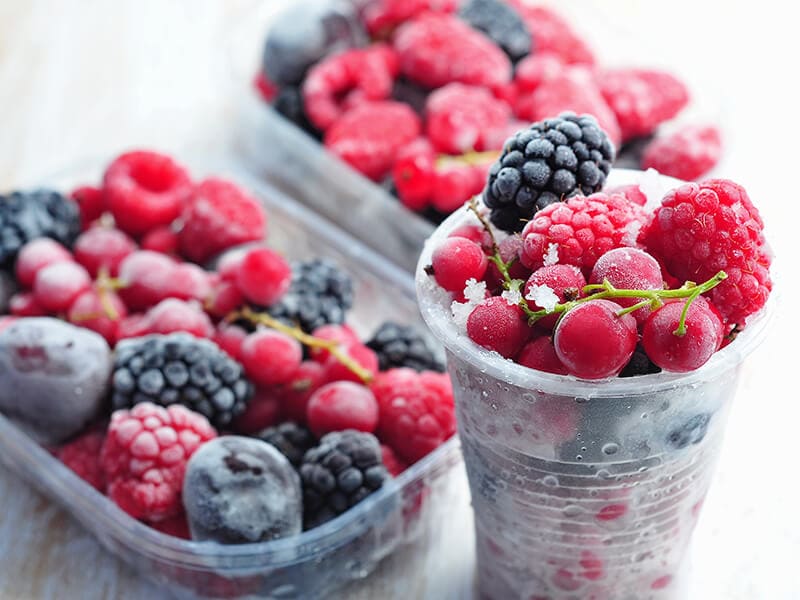
It is the safest way to thaw, but it will take some time. Using the refrigerator has the disadvantage of being worse than the other two methods, which is that the process can take up to 12 hours.
You should divide the amount of frozen fruit that needs defrosting into appropriate food containers, such as clean boxes, bags, or plates. They should be covered to avoid cross-contamination to other foods.
Use The Microwave
In some situations, thawing frozen fruit in the microwave can be a quick and convenient option. It saves you a lot of time and is easy to implement. There are 2 main methods to defrost fruits with a microwave.
A microwave is a familiar kitchen appliance in many households. If you wonder how to thaw frozen fruit, like berries, check this instruction.
Use Thaw Mode
First, check to see if your microwave has a food thaw mode. If it has a defrost mode, you may follow its instructions to set the right temperature for the amount of frozen fruit you have. This mode of your device optimally supports you in the thawing process.
It prevents the fruit from being cooked due to too high a temperature or setting at the wrong time. The steps of using the microwave thawing mode are:
- Step 1: Put the right amount of fruit in an airtight container with a little water to create steam. The appropriate ratio is 2 tablespoons of water for 1 cup of fruit.
- Step 2: Place it in the microwave in thaw mode. Note that you need to consider the container size with the microwave capacity to ensure safety.
- Step 3: Continuously check the fruits and stir them often until they reach the desired thaw level. Depending on the amount of fruit and different oven capacity, the thawing time may change. It can take 5 to 10 minutes or more.
Use Low Power Mode
Another way is using the low power setting of your microwave if your device does not have a defrost mode. Please note that when thawing, you must remove the packaging that is not microwave-safe such as styrofoam boxes, plastic bags, and cartons.
Here are some steps to thaw fruit on low power.
- Step 1: Similar to the thaw mode method, you choose a container or deep dish with a microwave-safe lid or film. Then, add two water tablespoons to one cup of frozen fruit.
- Step 2: Set the microwave for about 5 to 10 seconds on low power and then remove them to check.
- Step 3: If your fruits have not defrosted as you expect, repeat for another 5 to 10 seconds. By doing it, you can make sure that your frozen fruits are not overcooked or burned.
Note: If using a microwave to thaw frozen fruit, you must use them right away because they are partially cooked and can be contaminated if left out for too long.
Use The Cold Water
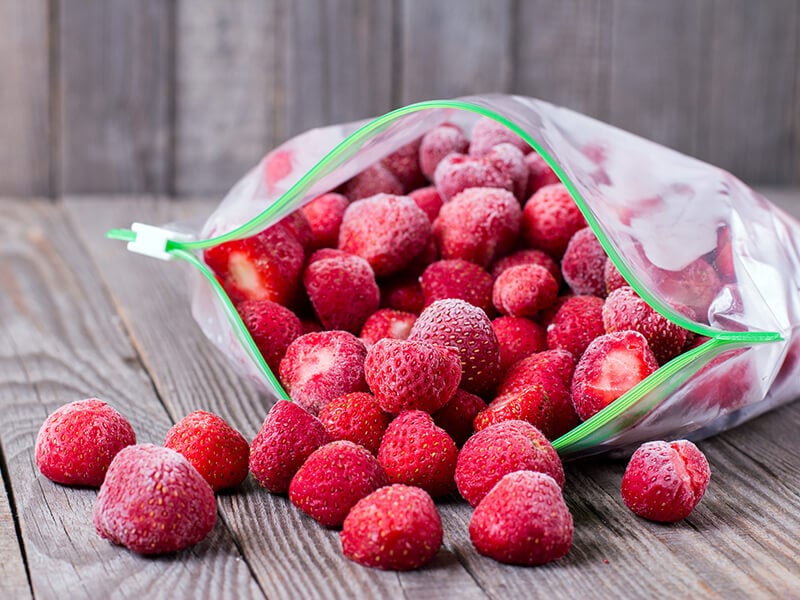
While thawing in hot water is a bad idea, using cold water is a safe method but requires a certain time. So if you don’t need to use that amount of fruit immediately, apply the following steps:
- Step 1: Place the frozen fruit in a sealed ziplock bag, remove as much air as possible from the bag, and keep out any water from the outside.
- Step 2: If you only need to thaw a small amount of fruit, you can run the whole bag under cold water until it is completely thawed.
Or you can also soak a sealed bag of food in a water bath and change the water every 15-30 minutes until it is all thawed.
Tips To Thaw Different Kinds Of Frozen Fruits
Different types of fruit have different sizes, amounts of water, and nutrient properties. Therefore, it requires you to pay attention to classifying each type by individual thawing methods. If you apply a random method to them, you may get in trouble.
Berries
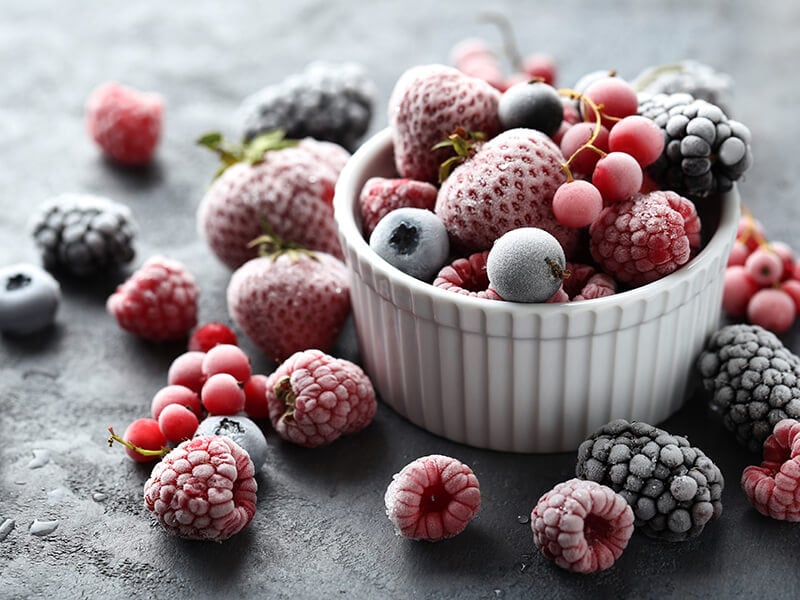
Berries are relatively small, juicy, thin-skinned, and perishable fruits. These include black raspberries, red raspberries, strawberries, cranberries, grapes, etc.
These are the favorite fruit varieties of many people. That’s why frozen berries have the highest frequency in convenience stores or supermarkets. However, if you need to thaw a large number, it is difficult for you to determine the correct way of thawing.
The best way is to defrost them in the refrigerator. It usually takes 5-8 hours to thaw frozen berries. But you have to keep them in plastic bags or a lidded bowl.
If you want to use them right away, you can microwave them on the lowest power or defrost mode. Check every 30 seconds until the fruit is fully thawed.
For cold water use, with a small number of frozen berries, do a quick rinse within five minutes. If the amount is large, they should be soaked for about 1-2 hours.
Stone Fruits
Pits or stone fruits are cherries, peaches, plums, etc. Their outer skin covers a soft and juicy flesh. Moreover, it surrounds a single, hard stone or pit containing the seed inside.
These fruits, when frozen, are usually peeled, seeded, or cut into pieces. The defrosting process is similar to that of berries. However, because these fruits are larger and retain a high amount of water, the refrigerator and cold water methods are preferable.
Citrus Fruits
Popular citrus fruits are oranges, grapefruits, tangerines, lemons, and limes. Their outer shell is thick, and the inside has a thin membrane that divides the flesh into segments.
If you need to thaw frozen whole fruit (such as lemons and limes), you can comfortably use the microwave and defrost them in 30 seconds.
If you thaw citrus fruits in slices, wedges, or cubes (such as grapefruit, oranges, and tangerines), you should put them together in a plastic bag and turn them over every 15 minutes in cold water.
Core Fruits
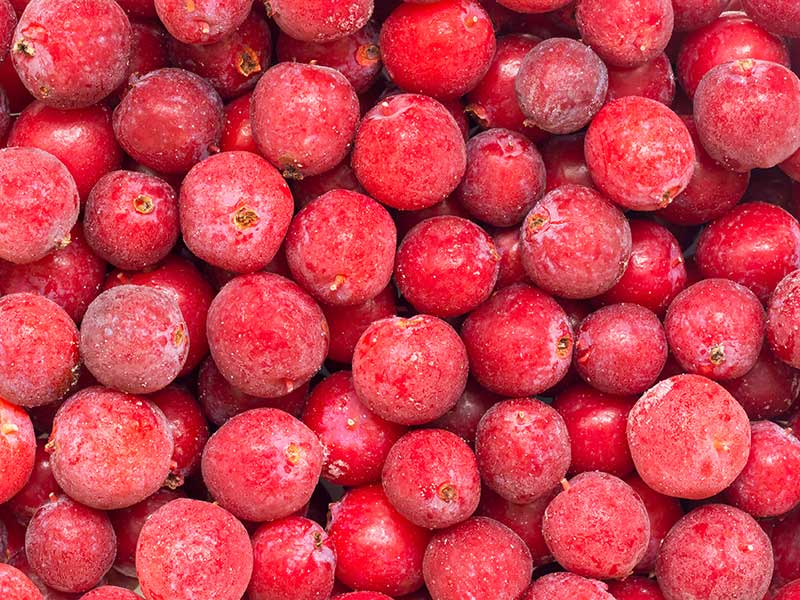
As the name suggests, core-type fruits contain a few small seeds and a central core. This core is covered with a thick layer of flesh. Some typical ones include apples and pears. Like citrus fruits, you can freeze them whole or cut them into small pieces.
The best method for this fruit, whatever its form, is to thaw it slowly in the refrigerator. It is harder to defrost than other fruits, so using the microwave or cold water can make them mushy, no matter if they are in a whole form or slices.
Melons
Referring to melons, watermelon is the most common variety. But there are many other types, such as cantaloupe, casaba, and honeydew. They have big sizes and taste sweet and delicious. Plus, they have thick skin and many seeds.
They are the fruits with the highest water content compared to the above-frozen fruits. So, when defrosted, they easily become soft, watery, and mushy. So you need to thaw them overnight or over 6 hours partially and slowly in the refrigerator.
The trick here is to line a large shallow dish under the container or plastic bag containing frozen melons to prevent water from leaking everywhere in your fridge. If you’re short on time, you can try speeding up the thawing process by rinsing or soaking in cold water.
Thawing time between different types of melons can vary. This will depend on the type of melon and the size of the pieces. Cantaloupe usually takes longer to thaw than watermelon because their flesh is less watery and crunchy.
Tropical Fruits
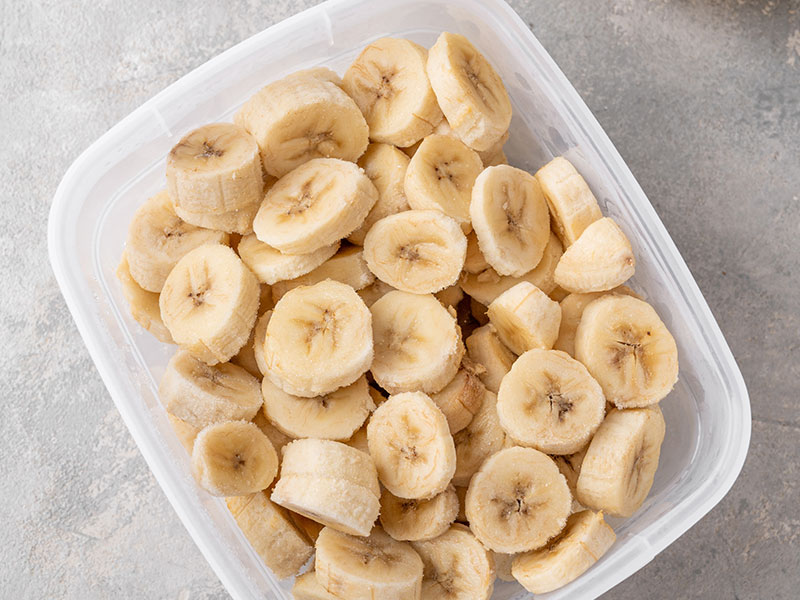
Tropical fruit is the general name for fruits that grow in warm climates or are considered somewhat exotic. Today, they are available worldwide due to being bred.
Some tropical fruits you may know like banana, avocado, fig, mango, pineapple, pomegranate, and kiwi. For convenience, fruits that require preliminary processing, such as bananas, kiwis, pineapples, or mangoes, are peeled and frozen in small pieces.
In addition to putting them in a container, to speed up the time, you can use a plastic bag or put them in a plate or bowl and cover them with cling film.
Then leave them in the fridge for at least an hour. If you keep them in a plastic bag, flip the bag over often so they can thaw thoroughly. If using cold water, you can follow the same procedure for other fruits and make sure to check every 15 minutes.
The second way is to use a microwave on low power to thaw frozen tropical fruit. Make sure to check them every 30 seconds to avoid overcooking and mushy.
Home-Made Flavorful Frozen Fruit Recipes You Should Try Once
I’m sure you’ve learned all the ways and tips to safely and quickly defrost foods while preserving their deliciousness and nutritional quality. So why do you hesitate to use them to make some delicious recipes below? I bet you will love it.
10-Mins Frozen Fruit Salad
Total time: 10 minutes
With just 10 minutes, frozen fruits, ice cream, cream cheese, and a few crumbs, this recipe brings back all your childhood memories. It is suitable for all ages, especially children, and reasonable for a hot summer.
If you love frozen strawberries, let’s try this recipe because they don’t require too many cooking tools or techniques. Alternatively, you can replace them with mildly acidic fruits like pineapple, peach, or kiwi.
This frozen fruit salad only takes you 10 minutes. You can save time by making it the night before and enjoying it the next day.
Grandma’s Yummy Frozen Berry Cobbler
Total time: 55 minutes
Frozen Berry Cobbler is perfect for family or friends gatherings that only take about an hour.
The secret is that you use frozen berries to save processing time and still provide a great source of vitamin C for the health of your members. Coating this dish with vanilla ice cream and walnut crumbs brightens up its flavor even more.
Mixed Berry Muffins
Total time: 30 minutes
These muffins are the best choice for an afternoon tea or snack. Frozen berry mixes are beneficial when they are mixed with a variety of fruits.
You can taste many flavors in one bite. At the end of the baking process, you should add a little lemon glaze to add freshness, interest, and extra flavor to this dish.
Overnight Oats With Frozen Fruit
Total time: 6 hours 5 minutes
How about a healthy breakfast? Overnight oats always require about 5 minutes for a delicious breakfast. You can use frozen berries, melons, tropical fruits, or pits for a lot of flavors.
When making overnight oats, you have oats, frozen fruit, and milk on hand. But be aware that you need to let this dish mix and leave it in the fridge for more than 4 hours for the best texture.
Why don’t you try making overnight oats with frozen fruit for this nutritious breakfast?
Common Mistakes When Thawing Frozen Fruits
Despite knowing how to thaw frozen fruit properly, many people still make many unnecessary mistakes. It not only directly affects the quality of the product, but also your health.
Cook Frozen Fruit Longer Than Usual
If you plan to thaw by cooking longer, it is not a good idea. Fruits cooked for too long lose their actual nutrition.
In addition, they can be overcooked, mushy, and of course, no longer taste good. It is best to apply the methods above so that you can use the microwave if you need to use it right away.
Refreeze After Thawing
Many people often put a large bag of fruit in the freezer and defrost a whole bag when in need. However, all of the thawed fruits should be consumed at once.
Thawed food is susceptible to bacterial contamination. So if you re-freeze the leftovers right after that, their quality is reduced. The best way is to divide the frozen fruit into small portions, which are enough for one-time use.
Do Not Clean The Microwave
The reason you have to put fruit in an airtight container with a lid is during defrosting, the juice from the fruit can ooze out or splash into the microwave. That water or leftover fruit crumbs can cause cross-contamination if you don’t clean the microwave afterward.
In addition, you are not only using it to thaw fruit but cooking a variety of foods from meat to raw fish. And they might contain bacteria.
Do Not Sort Frozen Fruit By Time
Different types of fruits should be divided into different bags. Plus, you should take notes of the time when you bought them for safe consumption.
Although the shelf life of frozen fruits is very long, they still have a certain shelf life. Ideally, you should make sure to use up all frozen fruits within the appropriate period to fully get all the nutrients.
Different foods in the fridge can cause cross-contamination and affects your health. This demonstration will tell you more about it.
FAQs
This article has shown you all the thawing methods, how to apply them, and a few yummy recipes that you can try with your favorite frozen fruit. Below are additional frequently asked questions. Hopefully, they will solve all your problems regarding thawing frozen fruit.
Thawing Frozen Fruit Is Easier Than You Thought!
Freezing is a great way to preserve nutrients for a long time, preventing the spoilage of fruits. However, while frozen fruit retains all of its essence, the wrong thawing process can destroy it all.
Frozen fruits are the best alternative for fresh ones when they are out of season. And defrosting frozen fruit is no longer a problem if you have read this article carefully.
With these tips, you can whip up many recipes with frozen fruits with ease. So if you find my post useful, please share it widely so everyone can learn good tricks to thaw fruits. If you still have other questions, please leave them in the comment section. Thank you!
Paragraph
- fsis.usda.gov. 2022. “Danger Zone” (40 °F – 140 °F).
- Nchfp.uga.edu. 2022. National Center for Home Food Preservation | How Do I? Freeze.

